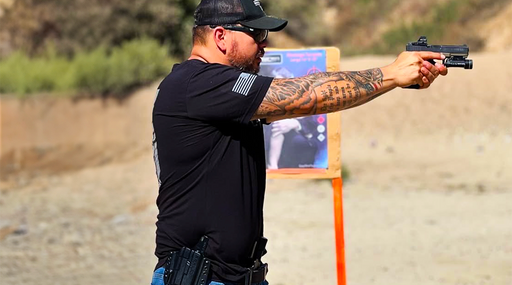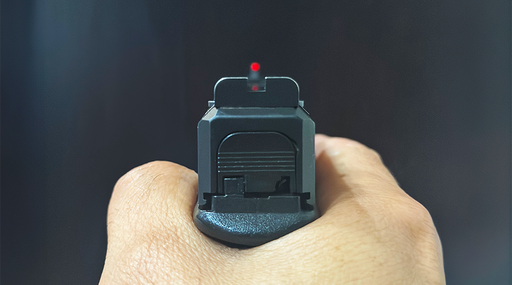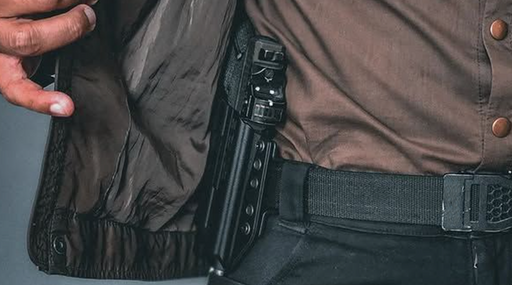
Among the many decisions required when choosing a concealment gun is size. For someone new to guns, researching this topic can be especially confusing because there is no defined standard for where duty- or full-size guns end and where compact guns begin. Likewise, what one calls a micro pistol might have similar dimensions to another brand’s subcompact. And the person dishing out advice might add the term “mouse gun” to the mix, which has implications of both caliber and size, yet no official industry definition. I’m not going to add to the confusion by making my own arbitrary labels in this article. Instead, I’ll address gun sizes in general terms and present the pros and cons of each, as I see them. Of course this discussion bears the biases based on my own experience and the observation of friends and students, many of whom has evolved their carry systems over the years. I’ll make every effort to be fair, as there are as many possibilities for gun carry as there are lifestyles.
Full- or Duty-Size Guns generally have a barrel of 4.75 inches or longer. Their standard-sized controls and magazine capacity make them easy to handle for adults with large hands and, with training and practice, they are the preferred choice of many people with less-than-large hands too. Their longer sight radius (distance between rear and front sight) makes maintaining sight picture easier. There is less felt recoil as compared to a shorter gun of the same caliber and materials. There’s a lot to love!
When it comes to concealment, most people cannot pull off carrying a full-size gun unless it’s in an off-body system such as a purse holster. And these guns have a way of making a purse weirdly heavy. But there are exceptions to this rule, especially for those who consistently wear a long overgarment like a parka and can manage to wear the gun outside the waistband (OWB) and still conceal it. Even IWB carry can be possible if a lot of sitting or bending is not part of the person’s day. A friend who works standing behind a counter all day is a great example of effective appendix IWB carry, with a full-size, light-bearing pistol with a red dot and an extra magazine all comfortably and invisibly hidden between the hip bones. That was until weight gain took away that “valley” between the hips. That person has since relegated that weighty assortment of products to OWB carry only.
All that said, there’s a segment of people who prefer a longer-barreled gun for concealment because the muzzle end of the barrel, pushing against their lower tummy, provides a flatter, better-concealed profile than a shorter-barreled gun, which for them creates a lever of sorts and makes the grip protrude under a shirt. At day’s end, the only way to know is to experiment and find out. If you’re one of the people hooked on the idea of carrying a full-size gun, consider pants with a longer rise that will hold the gun higher on the body.

Compact Guns in this discussion are those which are modestly smaller than full-size, with a 4.0-4.6-inch barrel. Glock 19 is a good example, though virtually every handgun maker makes one in this size range. They’re popular, and with good reason. Many people find them comfortable to conceal and easier to shoot than a smaller gun. Manipulations of the gun, i.e. firing, loading/unloading, drawing/re-holstering, and malfunction clearances retain the ease of handling that their full-size counterparts have. Thanks to their longer grips, painful pinching of the palm when inserting a magazine doesn’t happen.
These guns represent the sweet spot for many people. Many models can easily move from concealment to extended range training with a simple change of magazine to the full-size version’s magazine. My own duty gun setup utilizes this system, with a Glock 19 wearing Glock 17 magazines. It’s easier to get myself into and out of a seatbelt than when wearing the 17, yet I’ve not sacrificed ammo capacity.
Compact guns are a breeze for most people to operate but are still sizable. Despite my best attempts to pack one concealed, I haven’t found a setup that’s not painful when significant time is spent sitting. The closest holster I’ve found for this is the Bravo Concealment Linked Holster/Magazine Carrier, which distributes the load of the gun across my front. I can wear it standing or seated for up to, say, 20 minutes, without issue. But longer periods of sitting demand its removal. If you’re considering one, it’s worth a try. It’s super-beneficial to have a gun that can easily go from concealment to all-day range work without the need for a second gun and the extra training and gear usually associated with two guns.

Subcompact/Micro Guns are those which sport a barrel of less than four inches. The grip will also be shorter, making them easier to conceal. That shorter grip used to guarantee low ammo capacity or a very chunky frame. And that may still be the case, depending on your choice. Since Glock has a range of comparables in this vast category and most people are familiar with them or can easily compare them on the Glock website, I’ll use them as examples again here. From the lightweight 43 model, with a six-round 9mm magazine, to the thick 30 model, which jams 10 rounds of 45 ACP into the mag, there are a variety of choices in this category.
The term “micro” has been adopted by most companies making a 10-13 round basic magazine 9mm or 380 subcompact that has much of the shootability of a larger gun. Many people find these the perfect choice for concealed carry. Sig Sauer P365, Springfield Hellcat, Taurus GX4, and Canik’s new Mete MC9 are examples. Most have trigger operation that mirrors these guns’ larger stablemates and can accommodate a red dot sight. Many can accommodate standard-capacity magazines, making them a little easier to keep loaded on range drill days.

These guns currently rule the concealed carry world, and for good reason. They’re highly concealable and most are as easy to shoot accurately as their larger counterparts. If a person wants to carry a smaller version of their range gun to minimize the need to learn more than one gun, most major brands have a micro that’s basically a clone of one of their full-size guns. The mostly minor downsides in this category, as I see them, are as follows. Since these guns have shorter grips, it’s easier to pinch oneself when loading the mag aggressively (which to my mind is how it should always be done). So lightening the hold of the pinky or, for some, the bottom two fingers on the grip may be necessary when loading. Most subcompact guns are smaller enough in comparison to compacts as to require a so-called micro red dot sight, which can take some getting used to. And as guns get thinner, the finesse required to do certain tasks like racking the slide or ejecting the magazine becomes greater. But for most people, present company included, those small detracting factors are worth working past for the benefit of having a fine-shooting gun with familiar controls in a very concealable package.

Micro-Compact , “Mouse” Guns, and Derringers take up the smallest footprint of all, have short barrels from about 2.0-3.5 inches, and are of negligible weight in a pocket or inside a waistband. This makes them the top pick of many people. But the benefit of great concealability comes with some drawbacks.
Capacity is generally quite low, thanks to these guns’ small size. Six is usually maximum, and that’s in the 380 cartridge, which has a spotty track record for penetration depth. If you carry that caliber, best to live in a climate where folks wear lightweight clothing and exercise a lot! Also, due to the very small size of these, guns, fingertip manipulation is often necessary to perform basic tasks like locking back the slide. This is something many shooters find to be an impediment.
Chamberings vary, but if you want decent capacity, 9mm or 380 are usually the way. Bond Arms, for example, makes a great derringer in 45 caliber, but with two-round capacity. Then there’s Heizer Defense, making single-shot derringers in 7.62 x .39 and 223 Remington! For those who dislike recoil, Bond Arms offers many guns in 22LR or 380 ACP; in particular their Stinger is thin and favorable for concealment.

Also in the mouse gun category live popular choices from Ruger, the LCP (and its many generations, currently called LCP Max), in 380, and LC9. Each has undergone improvements over the years, but are still among the most difficult carry guns to shoot well, thanks to a combination of short sight radius and longer, heavier trigger pull. Also here I’d include single action choices from Sig Sauer called P238 and P938. These four models have historically been marketed to women, something I consider unfortunate as their tiny size and, in the case of the Rugers, excessive smattering of safety features render them difficult to be fast and accurate with, and even inconvenient for dry fire practice. Yes, they are reliable and accurate, but the time required to master the shooting or maintain any of these is, in my estimation, not worth the hassle when there are shorter paths between purchasing a gun and being competent and speedy with its operation. These comments won’t win me any friends among fans, especially those who paid at or near double market price for most any other pistol to own one of the tiny Sigs. All of the guns mentioned in this paragraph are hammer-fired, which means that field stripping and cleaning are a bit more complicated than striker-fired guns.
Glock is represented here too, with their 42, chambered in 380 ACP. I have carried a 42 quite a bit and strongly recommend a new or later-serial number used one; early models had notoriously quirky preferences where ammo is concerned. It’s easy to conceal, but with 6+1 capacity, it’s only slightly smaller than my Sig P365 with 10+1 in 9mm.

A Little Love for the Classic 1911. I’ve not given much attention to guns based on the 1911 platform here, so allow me to address them generally. Each size category has numerous choices of 1911 from numerous brands. If you have the readiness to deal with a single-action firearm with a beavertail and perhaps checkering that is likely to get hung up on clothing, it represents a worthy choice in general; especially as lightweight aluminum and polymer models show up in the market. In the micro category, I’m especially fond of Browning’s Medallion line of miniaturized 1911s. For the extremely short-fingered, they are usually a great fit. They’re reliable, accurate, and easy on the eyes, but not the easiest guns to match with a well-fitting holster.
In conclusion, remember that retail price and reliability are not necessarily correlated, regardless of gun size. My recommendation for gun size is as follows: Reliability comes first. The gun must be proven to function dependably with the ammo of your choice. With that box checked, if you can comfortably pack a compact or even full-size gun, it’s worth the effort in terms of having one tool for every job. If not, start working your way down the size spectrum. Many people find their dream gun in the striker-fired, robust-capacity, modern micro class. Still others gain massive confidence from having a tiny P238 in their pocket. Whatever you choose, judge it on the basis of your ability to rapidly hit what you intend to shoot at the distances you anticipate engaging any threat, typically 10 yards or less, without committing safety violations in the process. The word “rapidly” includes disengaging any safety features that are included on the gun, whether or not they require conscious effort to use. You need not break the bank to get a great gun. Plan on budgeting funds for training, ammunition, and holster experimentation along the way. Good luck on your concealed carry journey. As always, feel free to ask questions in the comments.





















Leave a comment
1 comment
Well done article. We’ve all been there, trying to choose the right gun to carry. I’ve gone from Commander sized 45’s to Sig 229’s and a host of others in between to finally settle on the Sig P365 and Sig P365 XL that I carry OWB in Bravo Concealment holsters. (I live in the frozen north so can get away with OWB for a good part of the year) They are one of the best bangs for the buck in holsters I’ve found.